Weekly Email – The Sunday next before Lent
Documents
Dear friends,
It was a great joy and privilege to spend last week in Walsingham for the Shrine’s annual Priests’ and Deacons’ retreat. The week of prayer and reflection usually takes a theological theme which is explored by a series of expert speakers. This year’s theme was an exploration of the role of Mary in the theology and practice of the Ancient Churches of the East. It was a wonderful week of theological discovery.
We were so lucky to have Rowan Williams present. He gave the first lecture in which he set the theological scene. In it, he underlined how important it is to be precise in our understanding of who we mean when we refer to the “Ancient Churches of the East” or alternatively, as they are also called, the “Oriental Orthodox Churches.”
Broadly speaking, these terms are used to refer to the group of churches in Syria, Egypt, Armenia and parts of India which did not subscribe to the teachings of the Council of Chalcedon in 451, and have preserved a different theological language to speak about Christ. (In other words, what we are definitely NOT speaking about is the Eastern Orthodox Churches of Greece, Slavic Europe and Russia.)
The Ancient Churches of the East stand in the Alexandrian theological tradition exemplified by St Cyril’s writings and place great importance on preserving a categoric unity at the heart of the person of Christ. They believe that to try to discern a human part of Christ’s being as opposed to a divine part, or to identify portions of his personality or actions as human rather than divine is to destroy the incarnation and make null its saving power. Indeed unless there was a unity of person in Jesus, he was no human being at all, but only a schizoid fantasy, or a zombie with multiple personalities, they argue.
The Council of Chalcedon sought to bring clarity and unity to Christian thinking on this subject by coming up with a compromise form of words that taught Christ was one “person” – i.e. he was one subject, not a psychologically divided being or an android mixture. Yet, that single person was the expression of two “natures,” divine and human, held together in the unity of Christ’s person and subsisting in him. This language became one of the most important foundations for the Church’s understanding of who Christ is, and was a way for “Chalcedonians” to ensure the two natures present in Christ were not understood to be confused, changed, mixed, or separated.
The problem for those who supported St Cyril’s teaching most strongly was that they feared this talk of two natures left open a slippery slope to picking apart the unity at the heart of the person of Christ. For this reason, the communities we now refer to as the Ancient Church of the East declined to assent to the teachings of the Council of Chalcedon. Ever since then they have been pejoratively referred to by history as “monophysites” – those who teach Christ has one nature not two.
Recent ecumenical dialogue and reflection has sought to unpick this unfortunate characterisation of the situation. It has attempted to establish what lies underneath this battle of terminology and philosophical wording. Miaphysites (as those who do not receive Chalcedon prefer to be referred to) argue their hesitancy about Chalcedon’s language does not imply they reject the importance of Christ’s humanity, nor extol a Christ who is more divine than human, or a mixture of the two.
Although, as Anglicans, we hold dearly to the definition of Chalcedon as the foundation of our Christology, Bishop Rowan argued we should approach the riches of the Oriental Orthodox theological tradition with an open heart, willing to listen and learn, rather than perceiving it through the blinkering perspective of past arguments.
Bishop Rowan reminded us that one of the most important lenses through which the history of the Ancient Churches of the East must be perceived is persecution. They have suffered more hardship and discrimination than any other group of Christians – first within the Christian Byzantine Empire, where the imperial authorities sought to suppress resistance to the definition of Chalcedon, and then within the Islamic World.
The fact that the Oriental Orthodox have rarely been allied to secular might or court influence means a Christian culture sprang up in these churches independent of political power, rooted in an acute understanding of Christian martyrdom, and frequently in close synergy with the needs of the outcast, the refugee and the marginalised.
Dr Sebastian Brock, of the University of Oxford, gave the second lecture and opened up to us the ancient riches of Syriac liturgical writing. The Syriac tradition has consistently approached the task of theological reflection in a more poetic way – leading to an allusively beautiful and theologically creative corpus of work.
Ancient Syriac poetry has a series of genres that simply do not exist in Western liturgical literature and hymnody. One of those genres is verse sermons, in which whole homilies were composed in poetic form. I fear I am certainly not up to the task of introducing this practice to All Saints’!
The Syriac tradition makes assertions about Mary through typological allusion. Her role as a Second Eve, for example, is very important. Many Syriac texts point to extensive connections between Mary and our salvation in this way: just as Adam slept and Eve was created from his rib; so as Christ slept in death on the Cross, the Church is created by water and blood from his side; and just as Eve prompted the Fall through listening to the Devil; so Mary conceives through her ear, by hearing Gabriel’s message.
A further genre of poetry very important in the ancient Syriac tradition is verse dialogues. Dr Brock read us two of these composed to describe both the Annunciation and Joseph’s acceptance of Mary’s pregnancy. They are remarkably life-like and go on for many stanzas. In the Annunciation dialogue, Mary’s is wily and hesitant at first as she works out the true import of Gabriel’s message and only acquiesces in his proposition late in the poem after an awful lot of persuasion! Just as Eve had responded too quickly to the Devil’s temptation, Mary is presented as wiser, feistier, and cannier in taking more time to consider her decision.
A third lecture was given by Archbishop Anba Angaelos, who is the Coptic Orthodox Archbishop of London. He revealed to us the remarkable affinity Egyptian Christians feel they have with Our Lady who sojourned in exile in Egypt. The route of Christ’s flight into Egypt is mapped out and venerated by Egyptian Christians, and gives them an acute empathy with the refugee and the displaced. Mary is felt by Copts to have a presence in Egypt unlike that in any other country. Egypt became a refuge for the Holy Family, which corresponds to her role as a comfort and refuge for those in need.
Archbishop Angaelos was, understandably, proud of the Alexandrian contribution to theology, and of the way in which it had defended Our Lady’s role as “God bearer.” He also introduced us to a number of beautiful typological allusions that lie at the heart of Coptic Marian spirituality, not least that of Mary as the Burning Bush – containing the divine presence yet not being consumed. This typology is embodied day to day in a beautiful Coptic liturgical understanding of why we burn incense. At every Mass, the placing of incense in the thurible is held to represent the incarnation, as the divine presence takes up its home in Mary’s womb.
I can’t thank the Shrine enough for a wonderful period of retreat, prayer and study. All of the priests and deacons present with me spoke warmly about how much they had learned. I certainly found it a wonderful week of theological discovery, which has prompted me to want to learn more about the theological and liturgical traditions of these ancient and venerable churches.
Fr Peter

His Eminence Archbishop Angaelos, Coptic Orthodox Archbishop of London, and Fr Kevin Smith, Administrator of the Shrine of Our Lady of Walsingham, after the Archbishop’s address to 100 or so priests and deacons gathered in retreat at Walsingham.
Many congratulations, Fr Alan!
We offer our best wishes, prayers and congratulations to Fr Alan Rimmer, who was licensed as our new Assistant Priest last Sunday at Evensong. We are so pleased he has discerned a call to serve God in our parish and assure him of our continued prayers as he takes up his new ministry among us.
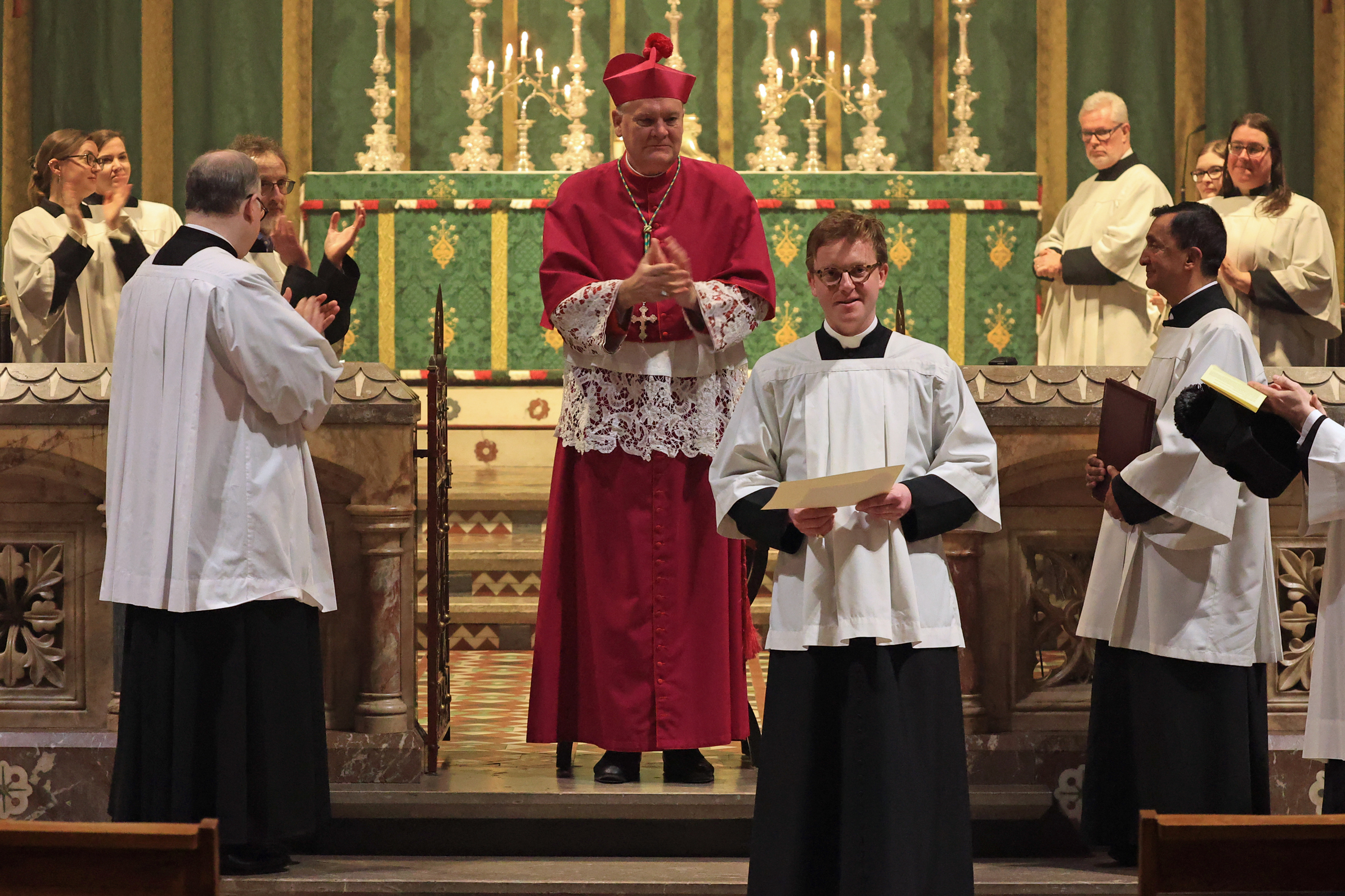
A round of applause is offered to Fr Alan Rimmer, upon his being licensed as our new Assistant Priest.
A Laetare treat
I am pleased to announce a mid-Lent parish trip to the Royal Academy to see their latest exhibition focussed on the treasures of Spanish art from the Hispanic Society of America in New York.
The visit will take place as a mid-Lent Laetare treat on Sunday 19th March at 3.00 pm. The idea is that there should be time enough for parishioners to grab a quick bite to eat for lunch, and then make their way to the Royal Academy from Margaret Street after the High Mass, but with enough time to return for Evensong for those who wish to be back for that.
The museum of the Hispanic Society of America in New York is currently closed as it undergoes renovation, so their amazing collection of art has been lent out to significant institutions across the world to allow people to see their treasures without having to go to New York.
I have to say when I went to see it the other day I was astounded by the amazing array of different historical periods, artistic media, religious perspectives, and geographic origins represented in the collection.

[Different media of artistic expression: left, a 16th Century processional monstrance made in Cuenca; right, a 15th Century Black Book of Hours for mourning.]
It extends right from Ibero-celtic torques and neolithic ceramics made in the “Bell Beaker” period, through the jewels of Medieval Christian art, to the Golden Age of Velasquez and beyond into the Twentieth Century with several Sorollas.
We see Christian art represented along side objects of Islamic and Jewish origin, and witness how a range of different religious instincts merge and interact in the medieval period creating a unique fusion only found in the Iberian Peninsula.
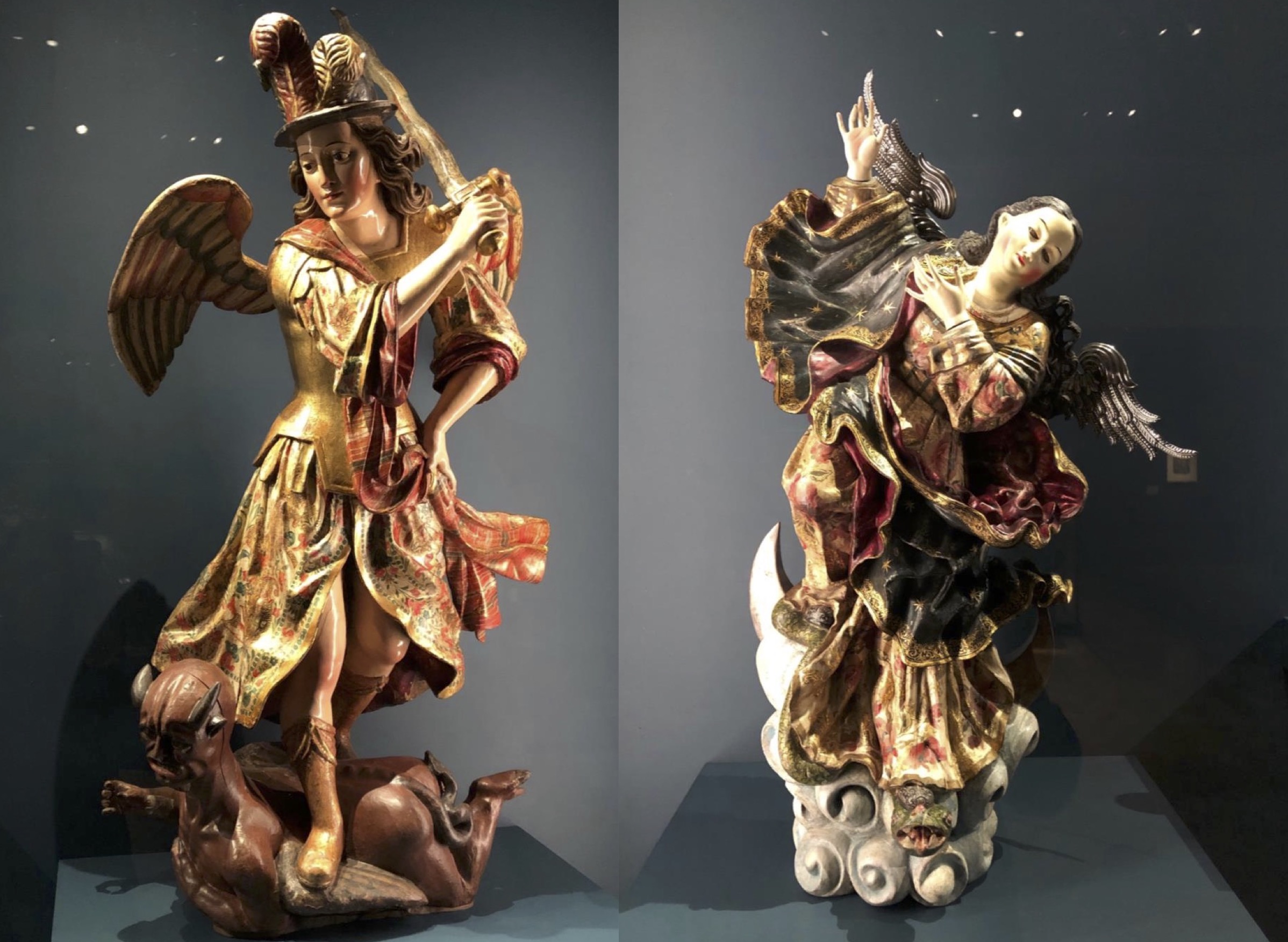
[Several marvellous examples of Spanish Counter-Reformation statuary from both “Old” and “New” World contexts are on display.]
There is also an extensive range of artworks from the “New” World, as the harsh reality of European colonialism meets a range of indigenous artistic styles in the creation of art with a very distinct voice. One sees both religious art from Latin America emerge with a creative perspective of its own, but also examples of decorative arts such as furniture, maps, domestic objects and luxury items which bear the unique stamp of having emerged in a Spanish colonial context far from Europe.
The exhibition costs £20. Please be in touch with our parish office to book a place.
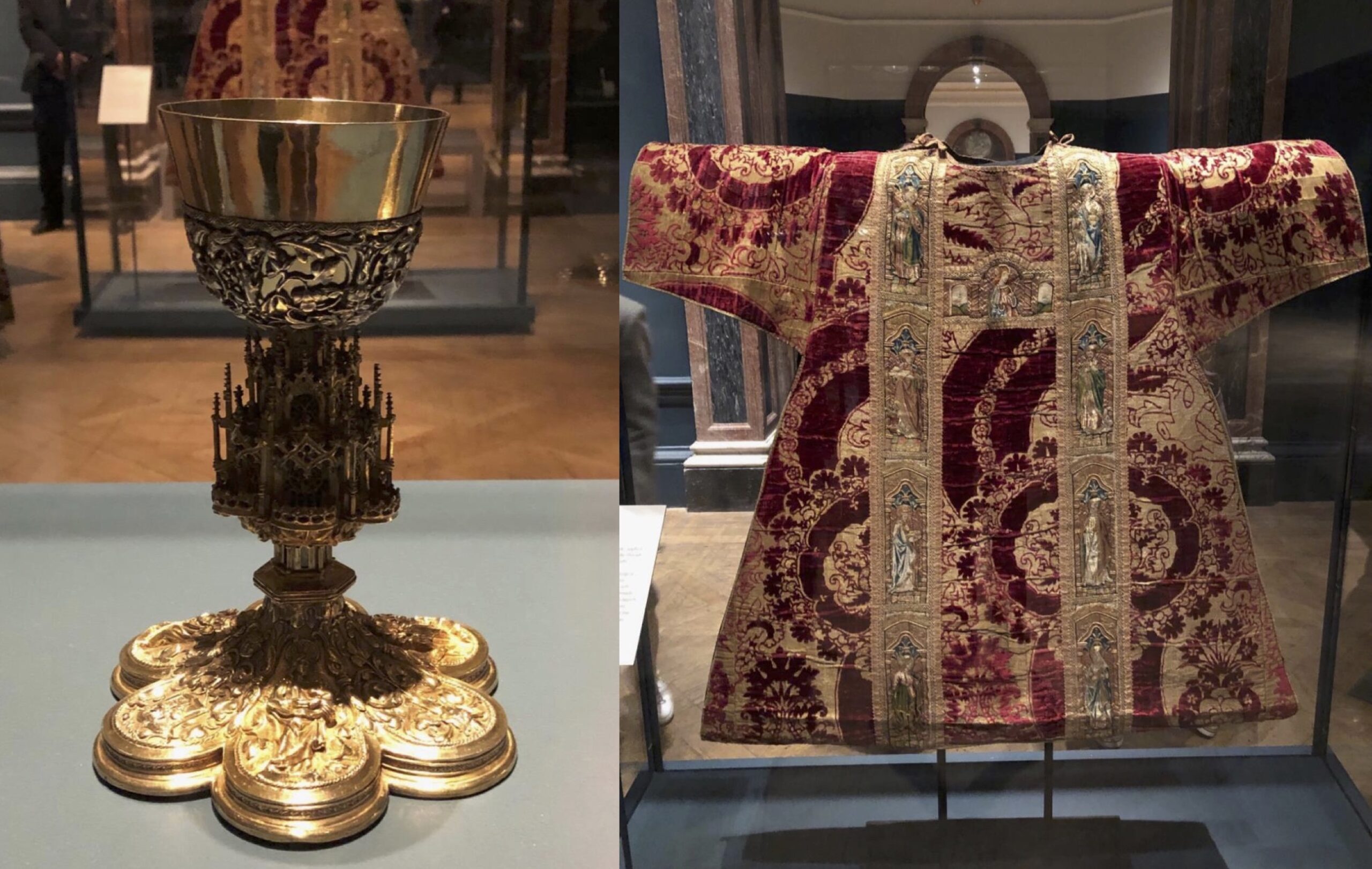
A array of beautiful Spanish liturgical items from the Medieval period await visitors to the Hispanic Society of America exhibition at the Royal Academy.
Stations of the Cross in Lent
We will follow our usual Lenten custom of offering Stations of the Cross each Friday in Lent after the 6.30 pm Mass. This is a wonderful way to enter more deeply into the mystery of the Lord’s Passion. Stations will begin on 24th February.
All Saints’ Lent Appeal 2023
Given the disastrous earthquakes in Turkey and Syria and the need to continue supporting projects working with those most in need, money raised this year through the All Saints’ Lent Appeal will be divided between:
DEC Turkey-Syria Earthquake Appeal through Christian Aid
This is a Disaster Emergency Committee made up of 15 charities including Christian Aid. DEC charities and their local partners are among the first responders providing urgent help following the disastrous earthquakes. Many thousands of men, women and children have died or are injured in the aftermath of the earthquakes in Turkey and Syria. Christian Aid has been working with local partners across the region for decades and responding to the Syria crisis since 2012. Even before this devastating earthquake, there were over four million people in need of aid in Northwest Syria.
The American Church Soup Kitchen
This contributes towards the costs of the Mental Health Worker who works at the American Church on the Tottenham Court Road. The Soup Kitchen is a resource for the homeless, elderly, lonely and vulnerable in London. They provide free meals, clothing, toiletries and a sense of belonging to nearly 150 people each day and an on-site mental health drop-in centre to help address their guests’ mental health needs.
The Bishop of London’s Lent Appeal
The Diocese of London is partnering with MANNA (Mozambique Angola Anglican Association) to help the traumatised. This year’s appeal aims to raise money to train leaders in Mozambique who can provide pastoral care and support for those with trauma. Since 2017, over a million people living in northern Mozambique have been displaced by a violent insurgency and 4,000 have been killed. This is a population which is now deeply traumatised. Many professionals have said that their need for trauma counselling and support is as great as their need for food, but agencies and organisations do not have funds for this.
You can make a donation to our Lent Appeal here.

- Fr Peter was very pleased to meet for lunch at Le Beaujolais with Dr Harry Bramma, our former Director of Music, along with Frances O’Neil and Ian Lyon, as a late celebration of Harry’s 86th birthday. Many happy returns, Harry, and thank you for all you contributed to All Saints’ during your many wonderful years as our Director of Music!
English Victorian Churches by James Curl
Parishioners may be interested in reading Richard Bowdler’s review of James Curl’s new book, English Victorian Churches in The Critic here. All Saints’ features prominently. Bowdler writes of Victorian churches:
“These churches were generally built in a single go, replete with fittings, and were the product of one architectural (and liturgical) vision. The pleasures derive from this totality of effect, on the handling of space, the deployment of bold materials, the learned drawing on historic sources, and on the fittingness of such ensembles for a particular style of worship. Curl is excellent on all of these, and his eye for a continental source of inspiration is extremely sharp. The pinnacle of his praise is in his description of Butterfield’s All Saints, Margaret Street (1849–59), the “finest memorial to the Oxford Movement, glowing, noble and assured” which he intriguingly compares with the work of John Everett Millais.”
Indeed, Fr Barry Orford has written the preface to the book. Bowdler quotes him thus: ‘The Victorians were heroic church builders, across all denominations. There’s the rub: there are just so many of these buildings to consider, and to care for. Barry Orford’s preface sets out the dilemma: “the Victorians, riding a wave of confident, mission-minded enthusiasm, built an excessively large number of places of worship … Superfluous to requirements today, these forlorn shells invite a superficial view that Victorian work is dispensable.” Curl’s mission is to demonstrate why these buildings matter.’

James Curl’s verdict on All Saints’ in his new book on English Victorian church building: “glowing, noble and assured.”
Zoom Theology: the Sacrament of Easter
Our next online Zoom Theology seminar will take place on Tuesday 14th March 2023 at 7.00 pm, and will be entitled, “The Sacrament of Easter: the Rites of Holy Week”
Fr Jeremy Haselock will explore with us the rich history of the rites of Holy Week: their origins; how we should celebrate them now; and their theological significance. Participants are encouraged to read the excellent work which Fr Jeremy co-authored with Roger Greenacre, “The Sacrament of Easter,” in preparation for this seminar. Zoom link can be found on our parish website here.
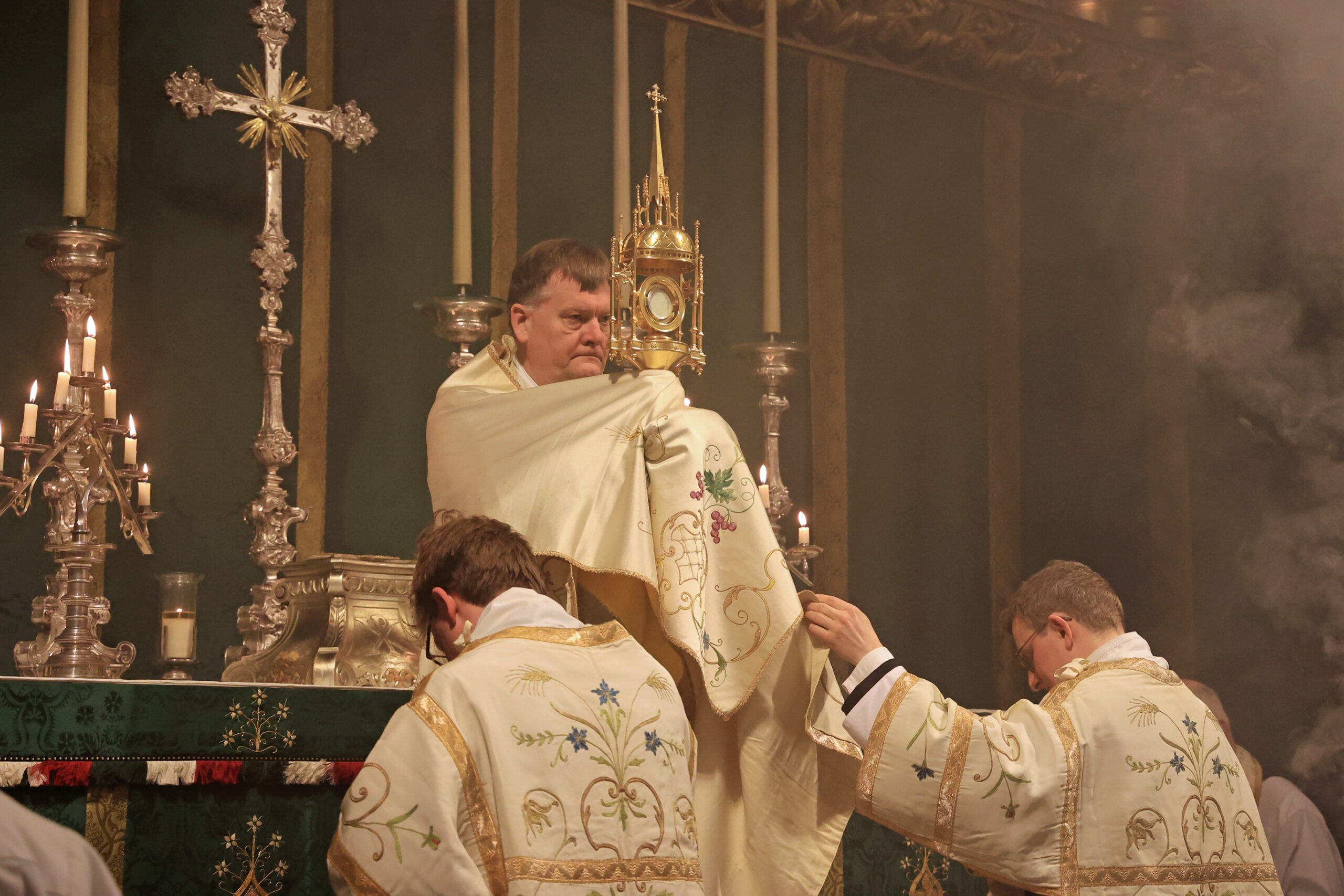
The Bishop of Fulham gave Benediction last Sunday after Evensong, and Fr Alan Rimmer, our new Assistant Priest was one of the sacred ministers for the first time. You can watch the liturgy here.
All Saints’ Lent Lecture:
Fruits of the Spirit – Art from the Heart
We are very pleased that the curator of the National Gallery’s virtual exhibition entitled, “Fruits of the Spirit – Art from the Heart,” the Revd Dr Ayla Lepine, will give our Lent Lecture in March on the topic of this interesting project. You “visit” the exhibition by clicking on the link here to enter a virtual gallery in the comfort of your own home wherever you are in the world. The lecture will take place at All Saints’ in person and online on Thursday 23rd March at 7.30 pm.

We are so grateful to everyone who helped dismantle the parish crib last Sunday. It comes into several pieces which are quite heavy and tricky to handle and needs storing in the cellar. Many thanks indeed to all those who helped!
Forthcoming guest preachers
Saturday 25th March 2023 – Feast of the Annunciation of the Lord
High Mass | 12 noon
The Revd Christopher Trundle,
Vicar, Our Most Holy Redeemer, Clerkenwell, and Chair of the House of Clergy, Diocese of London.
Holy Week Preacher 2023: The Bishop of Fulham
Sunday 2nd April – Sunday 9th April 2023
Thursday 18th May 2023 – Ascension Day
High Mass | 6.30 pm
The Revd Steven Brookes,
Chaplain, The Royal Hospital Chelsea, and Deputy Priest in Ordinary to His Majesty the King.
Thursday 8th June 2023 – Corpus Christi
High Mass, Procession and Benediction | 6.30 pm
The Revd Philip Warner,
Rector, St Magnus the Martyr, London Bridge.
Attendance Last Sunday
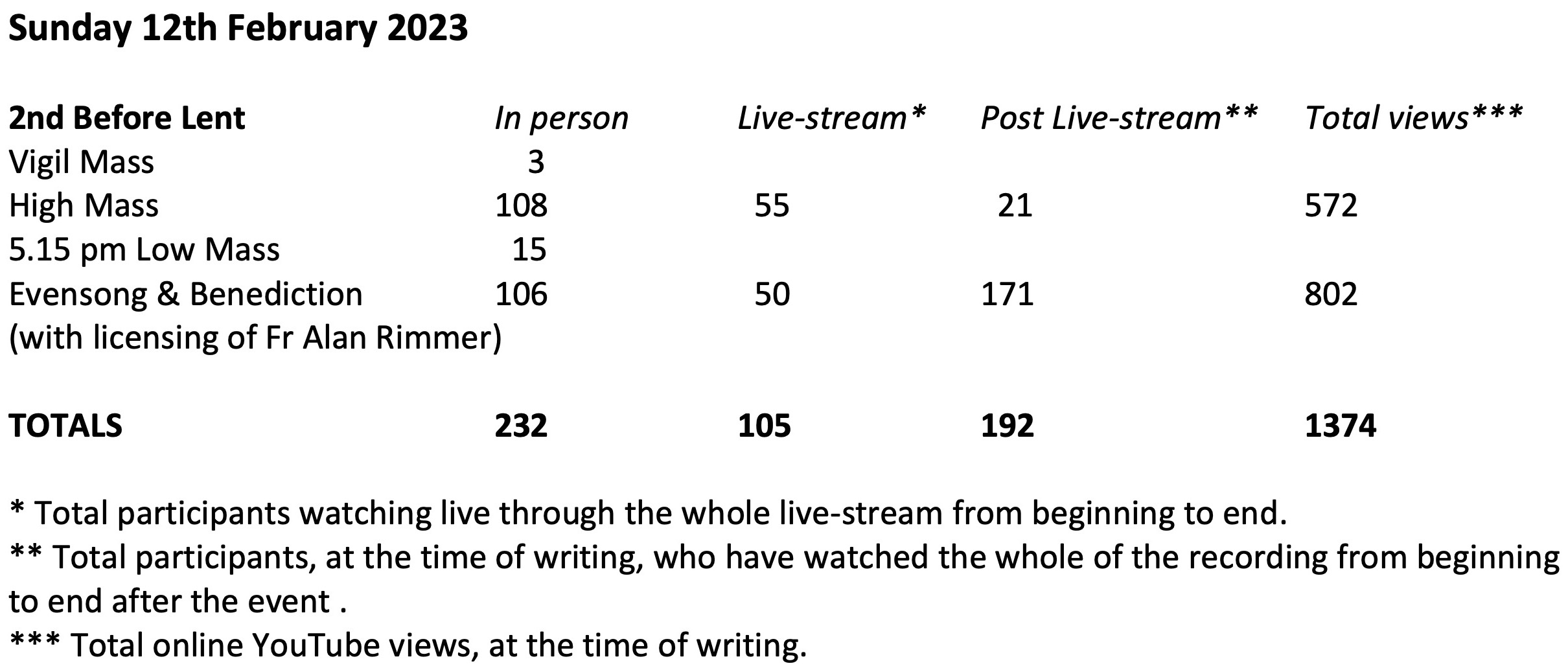
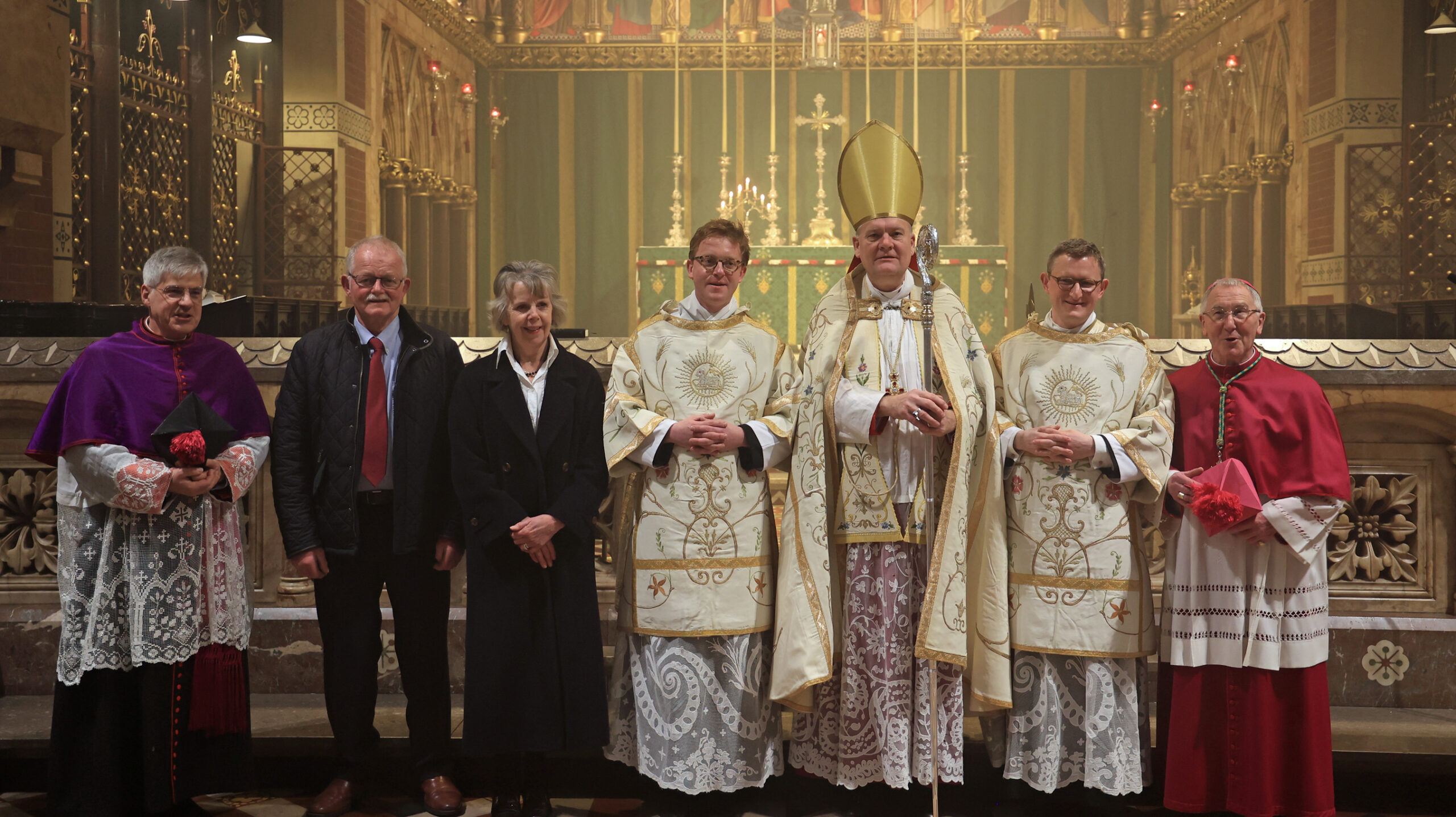
We were so pleased to be able to welcome many friends and visitors to Fr Alan’s licensing on Sunday, including his parents, Bishop Glyn Webster, and the Archdeacon of London, Fr Luke Miller.
Flowers
The flowers are given by Ray Oram to celebrate his birthday, which falls in Lent, in early March.
We are looking for volunteers to help with the flowers in church and the Courtyard Garden. If you have a particular talent for flower arranging or gardening, or can even help with watering or sweeping the courtyard, please contact Shawn on 07988 287 663 or shawnwilbe@outlook.com.
If you would like to make a donation for flowers or the garden, please contact Shawn.
Links for Sunday
The links for the livestream and service sheet for this Sunday’s High Mass are at the end of this email.
Evensong and Benediction takes place at 6pm this Sunday. Music will include Judith Weir’s Magnificat and Nunc dimittis and Bairstow’s Save us, O Lord.
Prayer list
The sick
Fr. Harry Hodgetts, Amanda Barrett, Greg Loveday, Theresa Moses, Don McWhinney, Martin Berka, Pete Turner, James Rodger, Andrew Rodger
The faithful departed
Joseph Lavelle (Marist Brother), Guy Rochette, Ron Capon
Anniversaries of death
February 19th – Mavis Symes
21st – Guida Crowley, Joan Williams
22nd – John Sanders Vickery
23rd – William Butterfield, Thomas Skeffington-Lodge
24th – James Keen
25th – Eleanor Alaway, Derek Beavan, Diana Stonebanks, Yoskyl Brackley
The Friends of All Saints’
February 19th – Anne Merritt, Hazel Miller, Thomas Moller, Barry Moore, John Morrell, Fr. Stephen Morris
20th – Inger Mosbery, Christopher Naylor, Fr. Philip Need, Brian Newman, Graham Norman, Elaine Norman
21st – Richard North, Fr. James Nuzzo, Priscilla Oakeshott, Anna and Fr. Peter Oesterby-Joergensen, Ray Oram
22nd – Fr. Barry Orford, Samantha Parker, Malcolm Parr, Bhaven Patel, Alma Pearson, Pat Phillips
23rd – Colin Podmore, Nick and Cecilia Powell, Simon Pusey, Simon Rainey, Carlos Remotti-Breton, Fr. Steve Rice
24th – John Rick, Hilary Rodger, Fr. Jim Rosenthal, Mossman Roueche, Greg Round, Mary Sherred
25th – Fr. Peter Simpson, Ingrid Slaughter, Gwynedd Sooke, Jason Stewart, Richard and Louise Stallwood
Service times this week
Saturday 18th February – Feria
12.00 noon Mass of Requiem
6.30 pm Vigil Mass of Sunday
Sunday 19th February – Sunday next before Lent (Quinquagesima)
11.00 am High Mass
5.15 pm Mass
6.00 Evensong and Benediction
Monday 20th February – Feria
12.00 noon Mass
6.30 pm Mass
Tuesday 21st February – Feria
12.00 noon Mass
6.30 pm Mass
Wednesday 22nd February – Ash Wednesday
12.00 noon Mass with imposition of ashes
6.30 pm High Mass with imposition of ashes
Thursday 23rd February – St. Polycarp
12.00 noon Mass
6.30 pm Mass
Friday 24th February – Feria
12.00 noon Mass
6.30 pm Mass
7.00 pm Stations of the Cross
Saturday 25th February – Feria
12.00 noon Mass
6.30 pm Vigil Mass of Sunday
Sunday 26th February – First Sunday in Lent
11.00 am High Mass
5.15 pm Mass
6.00 Evensong and Benediction
